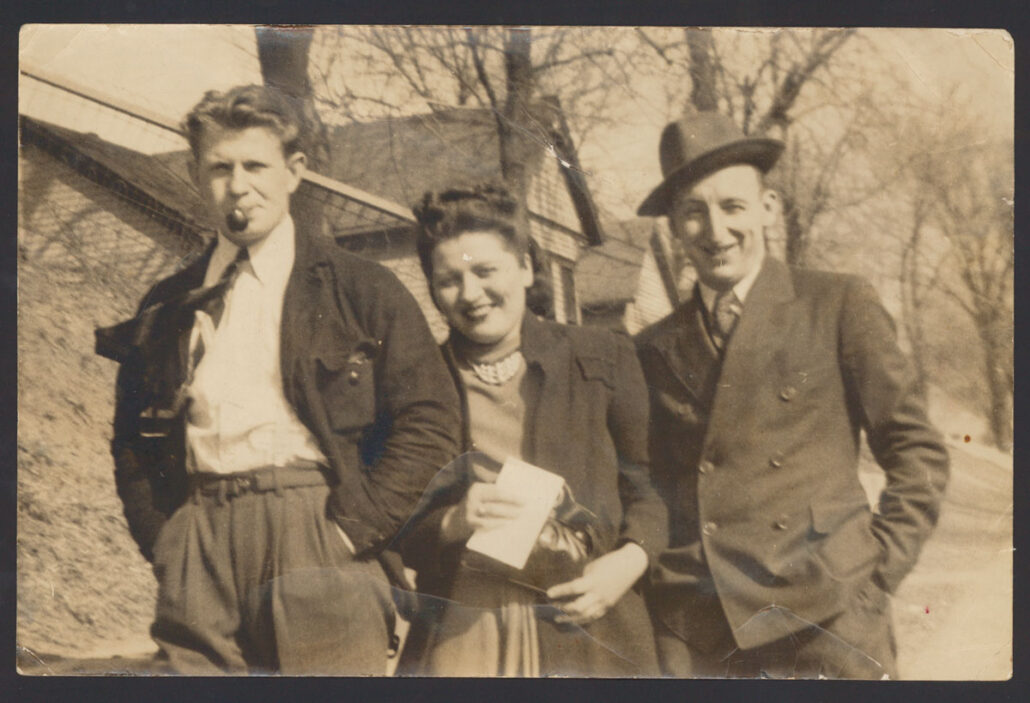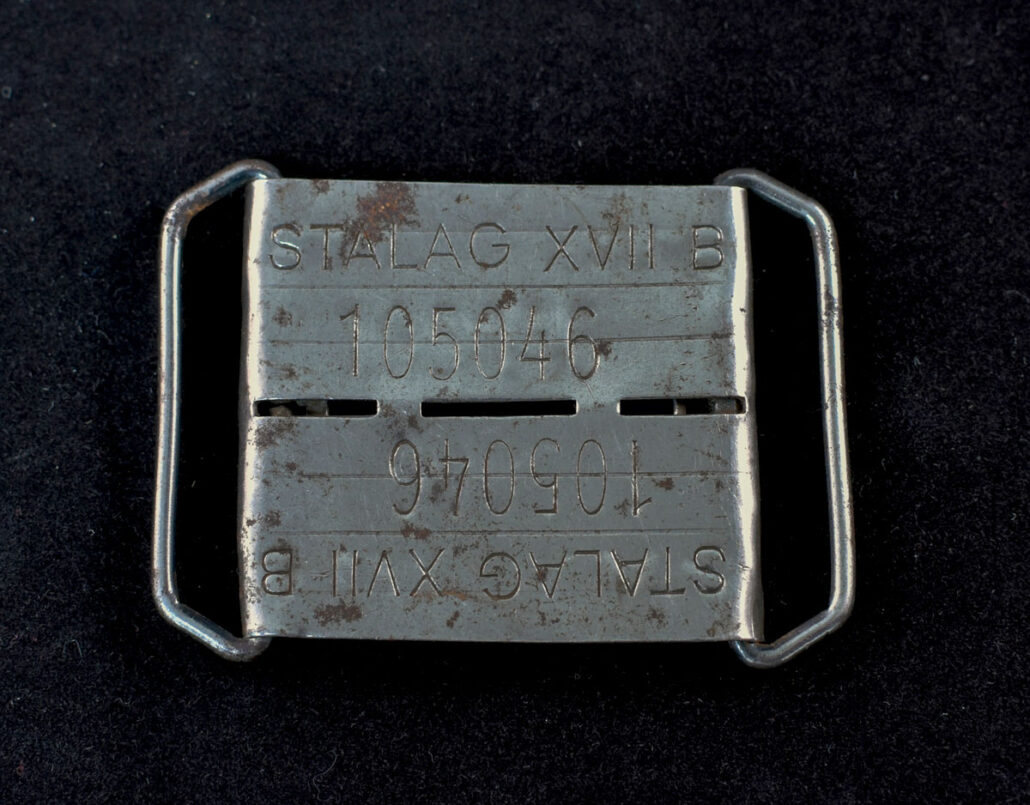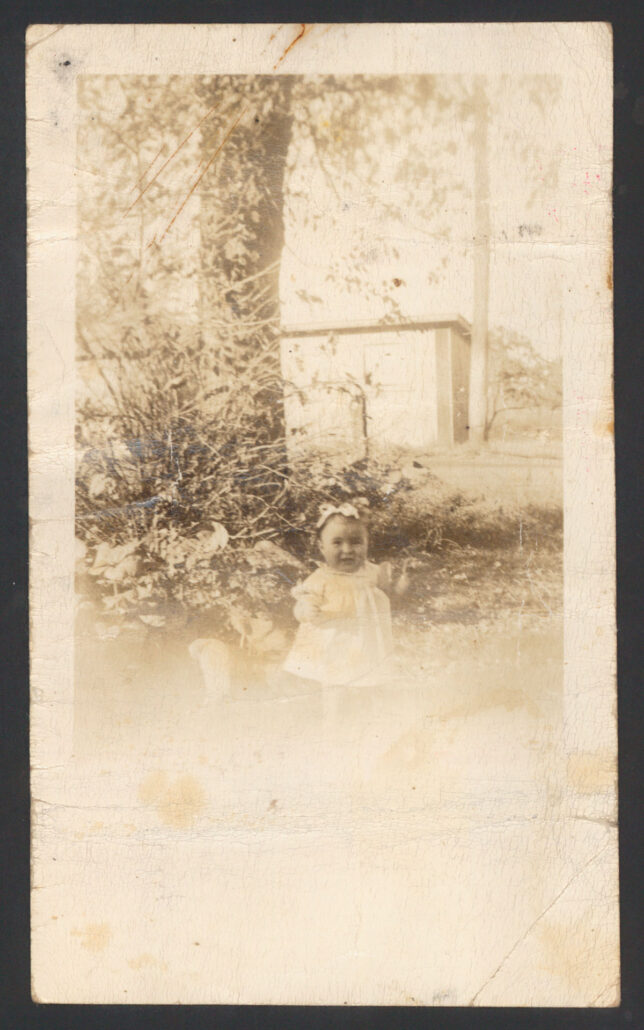POW belt buckle. Image provided by Christopher Parrish and used with permission.

By Team Lead Marcia Spicer
While much of the country braced for a pre-Christmas polar vortex and snowstorm, I got to speak with Christopher and Molly Parrish via Teams from our respective homes. The Anderson Archival team has fond memories of digitizing their dual-family collection in 2021, and after a year of utilizing the digital files, they were happy to share how the collection has enhanced their lives.
With the family Christmas tree behind them, Molly and her father Chris talked about history, connection, and how digitization can keep stories alive—the stories of two incredible family lines. Jack and Maurine King, Chris’s maternal grandparents, exchanged letters throughout World War II and during Jack’s time as a POW. Richard “Dick” Parrish, Chris’s paternal grandfather, was, among other things, the first inductee into the Iowa Harness Racing Living Hall of Fame.


Left: An acquaintance with Maurine and Jack King. Right: Dick Parrish harness racing. Images provided by Christopher Parrish and used with permission.
Anderson Archival: When you were thinking about digitizing, how did you decide that you needed to embark on this project?
Molly Parrish: When I was in junior high, I was in 4H and was working on a project doing family history. I was out on my grandpa’s farm, and we had found all of this stuff lying around. [After that project] I kind of moved on with my life. But in grad school I was taking a class called “The Human Face of Battle” where we were studying about the different emotions it takes to be a soldier in war.
We were talking about the B17 crews and how it’s different to go to battle as someone on a ship versus the emotions it takes to fly a plane or be on the battlefield itself. When we were talking about the Air Force, we were studying World War II, and I just happened to have a box in my apartment of all these things [from the 4H project about Jack King]. I brought it in to class.
I noticed that since the last time I saw them, things were starting to get faded. There were a few things I was ripping as I was pulling them out of the box. I decided that if people beyond me wanted to see it, we needed to do something to preserve it. I brought that up to my dad and my grandpa and said, “This is really cool stuff. It’s valuable to us as a family to keep. I think we should look for a way to preserve it… It’s up to us to preserve it.”
You were obviously familiar with a lot of these materials, but what were some things that you didn’t know about your family before digitization?
Christopher: I have to say, I didn’t know my grandpa very well. He died when I was three. A lot of the stories that I had heard were handed down by his brothers and sisters.
Molly: I didn’t know very much either because I’d never met [my great-grandpa Jack]. At that time, my grandma [Maurine] had passed away so she wasn’t able to tell us about her dad.
Luckily, Maurine kept basically everything. We were able to figure things out by reading the letters the best that we could… try to put them in order and getting on the Internet and looking at military records and things that happened around that time. For example, the food rations. What are those? How did they use those? What does this patch mean? What does this medal mean? It did take a lot of research because there just wasn’t anybody around to tell the story.
Things were starting to get faded. There were a few things I was ripping as I was pulling them out of the box.”—Molly Parrish

Christopher: A lot of the letters were in boxes that we had taken out of my grandma’s attic. Luckily, we found them before the mice had gotten to them.
The pictures, the bayonet, those things I had known about. I had taken them to show and tell when I was in elementary school. The only thing I didn’t know about was the prisoner of war belt buckle. It must be rare that people keep those because I’ve only ever seen one other one, and that’s out in DC at the Smithsonian.
When you were planning for digitization, what were your biggest concerns?
Molly: When you think about digitization, in my mind, it’s not something that a family [normally] goes and does. It’s something that a museum would do, because they would see this piece of paper and know it’s worth digitizing. [I was wondering] is this something that we should even do? Is it going to work? A lot of this stuff was so fragile that [I didn’t know if it would] actually scan. Will it survive the trip, and back? Because as much as we like the digital collection, it’s also still meaningful to have the actual letters.
Chris: A lot of mine were, okay, what’s going to happen? How’s it going to look?
In that initial meeting that we had with [Anderson Archival] a lot of my fears were taken care of. I knew that it was going to be in good hands.
Now that you have the digital collection, how have you been using it?
Christopher: Once we got the digitization back, I was reading the letters. I hadn’t read a lot of the letters [before]. There was a letter that [Jack] had written and he said “Well, I wrote your name, Maurine, and Cheryl’s name on one of the bombs that we dropped today on Germany.” I didn’t know that. It was so cool to see that in the letter. And “Well, we’ve had our first success. Hopefully we’ll have another one.” And on the third one, they got shot down.
Molly: Once we got the digital collection, we were able to see these things more because we weren’t worried about handling them. I wasn’t worried about handling them as a junior high student because I didn’t understand. Now I’m out of grad school and I’ve seen these things, and I didn’t want to touch them. I hadn’t read many of [the letters] either, at least not in full. I learned so much, especially now that we can look without worrying about causing damage.
We each saved it in our own way that works best for us. For me, that was in a Google Drive where I have everything sorted.
Christopher: I have them on the flash drive and a copy on my computer. When we went to a wedding [recently] I looked through [the collection] to see if there was anything I could take with me. One of my ultimate goals is to have a book made of them so we have a hard copy. Just in case.
Molly: For family members, like [Chris’s] dad who doesn’t use a computer. Even though we took a physical product, digitized it, we can now put it back into a physical product. And people can enjoy it without worrying about, again, damaging things.
The way I’ve used it is, I just really enjoyed being able to see things. My classmates were all interested, so when we have discussions, I’ll pull it up. [Chris,] you use it in a more productive way than I do. I use it because I enjoy looking at it. And you’re using it to share with the rest of your family.
Chris: My dad, when we first got it, he came up and we went through all the stuff. He was just amazed at all the letters. One of the things that amazed him was the image somebody drew of Jack while they were in the prisoner of war camp. Somebody drew it and signed it on the back, noted the date, it was New Year’s Day, 1945. Just being able to see those images, like the map of Germany so that if they escaped, they knew where to go… He didn’t remember ever seeing those.


Is there any one item that has a story that resonates with you that you’d want to share?
Molly: I can think of one for me. There is one picture of my grandma that’s very faded. I believe she’s just sitting on the ground and was very small. It was a picture of her as a baby that [Jack King] kept in his pocket with him the entire time he was in the military and when he was a prisoner of war.
Chris: On the back of it, it says Stalag 17, and his prisoner of war number.
Molly: Just the fact that he was able to carry that around with him. He was in training when she was born, so he hadn’t known her for very long or spent a lot of time with her, but he did carry that around with him. In all the letters that he wrote, he always signed it “to my two brown-eyed babies” which would have been my [great-]grandma Maurine, and then Grandma Cheryl.
I didn’t know my great-grandma Maurine, but that was the most special for me. I could feel a connection to it. I’m named after Maurine. To be able to see that was really special for me.
Chris: Then also the picture of my grandpa Parrish being in the Hall of Fame. He was the first one inducted in Iowa. As we were doing this, my dad and I talked a lot more about harness racing. It was interesting going through it, trying to pick what to send to [Anderson Archival]. With my grandpa Parrish we had a huge tub of memorabilia from harness racing. I remember going into the house and seeing all the trophies.
Molly: That’s another point to make. The process of doing this with our family was very nice, because you don’t just sit down and talk about people. This was an opportunity for us all to sit down together. We never had the opportunity [before] to ask, “Why are there all of these bells hanging in the garage?” and those were the bells they would put on the horses. It’s things like that that’s really special and brings the family together. It was a push to sit down and talk about these stories before the people that know the stories are no longer with us.
Had we not done this, I don’t think we would ever have [talked through the collection].
In that initial meeting that we had with [Anderson Archival] a lot of my fears were taken care of. I knew that it was going to be in good hands.”—Christopher Parrish
Is there anything else you’d want to share with people looking for digitization?
Molly: If you’re on the fence of trying to decide whether to digitally preserve something, it’s definitely worth it. The process of doing it is special, and then you get the product afterwards that is special. [Anderson Archival] handled everything so well. The way you sent it back to us was so useful and so well organized. We were able to immediately take things and find one picture out of 100 pictures. Even things I thought would fall apart turned out beautifully. Everything was handled with so much care. We really enjoyed working with you. If we had more things we wanted to digitize in the future, we would come back.
We’re so blessed and honored to have been a part of digitizing and sharing your family’s story. So, thank you for that.
Chris: I appreciate all your help and everything that you did for us.






